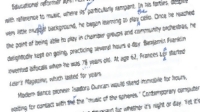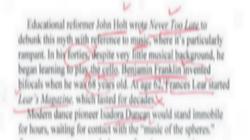Preparing Your Book Proposal or Manuscript for Submission
by Marcia Yudkin
How complicated can it be to print out and duplicate a copy of a book proposal or manuscript and send it off to an agent or editor? Although you are about to read what may look like a list of rules for preparing a submission, think of it as steps you can take to ensure that you and your work are taken seriously. I have seen every one of the guidelines below (and more) violated, including by some very smart people, so I know that these points do not "go without saying."
If you've been in the corporate world, you know not to show up at an important job interview lugging your dirty sneakers in a gym bag or handing over a ten-page resume. In the publishing world, too, agents and editors have certain needs and expectations. If you prepare your material to meet those needs and expectations, you avoid annoying or putting off these readers. Each guideline in the list below has a reason behind it and is not an eccentricity or arbitrary custom.
|
First impressions and ease of handling get you past the first hurdle in getting your work into print!
1. Your material must be clearly identified as yours. This means that the cover page of your proposal or manuscript must include your name, address, and telephone number. Your cover letter can get separated from everything else you sent
- and you do want to get a reply, don't you?
Every succeeding page must also include a "slug" (also called a "header," usually in the upper right corner) consisting of your last name or a short version of the title of the book project. This is important in case a gust of wind comes in the window and blows your manuscript pages onto the floor along with someone else's.
|
|
Published! How to
Reach Writing Success
|
|
2. Pages must be numbered. Without page numbers, the reader can't easily assess the total length of the material or refer to specific parts of your submission in comments. You can number pages at the bottom center, bottom right or top right. A good way to do it is to combine the slug referred to in #1 above and the page number in the upper right corner, like this:
Smith 46
3. Spell the editor or agent's name correctly in your cover letter. Double check that you've gotten it right! Even triple check it! I can't tell you how many times I've seen letters where names are spelled correctly in one spot and incorrectly about one inch down the page. This shows such obvious carelessness that the editor or agent becomes instantly on guard that this submission comes from someone who can't be trusted to get the facts right.
4. Perform a spell check on everything before you send it in. Your word processor's spell check function won't catch every mistake, but failing to use it (experienced readers can tell from the kinds of mistakes they spot) sends another telltale signal of carelessness.
5. Single space a letter; double space a proposal or manuscript. Material that is single spaced cannot be easily edited. Sometimes it's even difficult to write casual comments on single-spaced material. It's also more difficult to read single-spaced material.
 |
Improve Your
Proofreading
Quick online course teaches how to
catch pesky typos. Whether you check
writing on screen or on paper, learn the
stakes for error-ridden copy, the five
best proofreading methods and the tools
you can or shouldn't use to identify
errors. Includes practice tests and
answers.
Proofreading Hacks course. |
6. In your proposal and manuscript, indent each paragraph five spaces. Do not use the increasingly popular "block" style of starting each paragraph at the left-hand margin and skipping a space between paragraphs (the style you see here). With the "block" style, when the reader turns to a new page it's sometimes impossible to tell whether the first line is also intended to be a new paragraph.
7. Do not "justify" your right-hand margin. Use "ragged right" margins, where each line ends where it happens to end rather than along a straight vertical line. With justified margins your work is harder to read. Published books use much higher-quality justification procedures than are possible with the typical word-processing program. Your eye might not tell the difference, but someone who reads manuscripts all day notices.
8. Do not use hyphenation. If your manuscript is accepted, someone will have to manually cancel each hyphenation to prepare your work properly for typesetting.
9. Submit your material bound only by a clip or placed into a cardboard manuscript box. This seems counterintuitive
- isn't it easier to handle a manuscript when it's securely together in one piece, either stapled or bound with a comb or spiral? When you submit something bound you will have made it much harder or impossible for the agent or editor to make a copy.
10. Don't bother dressing up your material with a fancy cover. It won't hurt you if you create an elaborate cover, but it won't bring you any closer to success, either. Agents and editors are accustomed to reading plain, unadorned words and imagining them in a finished book.
Copyright 2006 Marcia Yudkin. All rights reserved.
|






